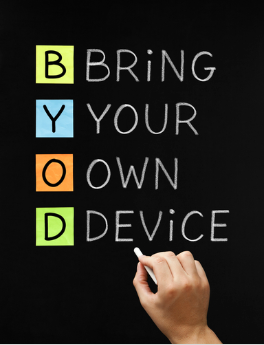- A Granite State Communications Company
Bring your own Device (BYOD) and Internet of Things (IOT) Adoption
Bring your own Device (BYOD) and Internet of Things (IOT) Adoption


In this article we will focus our attention on the BYOD concept and trends, along with some of the pros and cons that business should consider before embracing this strategy. In our Q3 newsletter we’ll dig more into IoT, and how the growth in this area is significantly impacting how businesses are approaching their computing architecture and policies.
Of course, the BYOD terminology encompasses far more than simply the concept of your employees going about their day-to-day tasks while carrying their smartphone in their pockets. The BYOD concept is that employees can actually work on their personally owned device to conduct business. For most companies this concept is not viewed as an exciting proposition as it’s not the traditional approach to creating a computing environment that is consistent, and easy to maintain and manage. While there are certainly benefits associated with minimizing the cost of equipment and deployment to ensure employees are properly equipped with the needed technology, it also comes at a cost operationally. A properly implemented and governed BYOD strategy can provide significant benefits. Cost savings is certainly the biggest, but don’t lose sight of the fact that a well implemented BYOD strategy creates a flexible working environment that can bolster employee motivation and productivity. It’s also a well documented fact that employees work faster and more efficiently when using technology they are familiar with, rather than having to adapt to equipment or technology that may be foreign to them.
In this article, we’re going to:
- Assess the underlying drivers of BYOD.
- Summarize statistics concerning the use of consumer devices in the workplace.
- Talk about the best practices to ensure a successful adoption.
If you are accustomed to working on a desktop computer, at a traditional fixed workstation, the idea of using your own device for work might seem a little strange. That said, the number of people who incorporate their personal devices into their professional lives has steadily increased since the advent of smartphones, laptops and tablets. Even the simple act of scanning or responding to work emails on your smartphone or laptop while riding the train home, or doing so before bed, blurs the line between professional and private lives. Here are a few statistics to help you understand the growth in the BYOD strategy and implementation:
- The BYOD market is on course to hit almost $367 billion by 2022, up from just $30 billion in 2014. (Source: BetaNews).
- 61% of Gen Y and 50% of 30+ workers believe the tech tools they use in their personal lives are more effective and productive than those used in their work life (Dell).
- 60% use a smartphone just for work purposes while 31% of those people would prefer a single device for both personal and professional use (Dell).
- Companies favoring BYOD make an annual savings of $350 per year, per employee (Cisco).
- Using portable devices for work tasks saves employees 58 minutes per day while increasing productivity by 34% (Frost & Sullivan).
BYOD might sound like a win-win concept, but there are important considerations to be made before deciding whether it is a workable solution, both from the perspective of employer and employee. Security is by far the biggest and most important concern when looking to adopt a BYOD strategy with your business. There are undeniable risks in permitting employees’ access to corporate resources from personal devices, and indeed the dangers posed by malicious applications and viruses discourages many organizations from implementing BYOD. The very real prospect of cyberattacks is understandably frightening for business owners.
In parallel with security concerns there is also the risk of sensitive company data being stored locally on an individual’s computing device. Even worse, what if the device is lost or stolen? Such an eventuality could pose a serious security risk, particularly if hackers or data thieves gain access to sensitive information. A lost device can also mean loss of critical or sensitive information, whether in the form of notes and memos or presentations, worksheets and other valuable documents. This could be especially problematic if you work in a sensitive sector such as legal affairs, politics or the medical field that require stringent compliance.
Before arbitrarily tightening security prior to a BYOD adoption, businesses should think long and hard about the process of gearing up for BYOD. After all, it’s not just a technical decision, but one that impacts multiple organizations within your company, and has far more reaching implications. Various stakeholders within your company should be engaged, and they are likely to deal with matters as disparate as employee eligibility, questions of funding, device selection, support models, records management, training and support, employee privacy, audit requirements, data usage limits and backup, termination policy and other legal considerations.
Companies need to ensure they address the core operational and technical aspects to ensure the success of a BYOD implementation, and minimize the risks. Along with having the appropriate technical components in place every company should develop the appropriate policies, processes, and procedures to efficiently and securely connect a personal device to their company network. Ensuring that any device being connected can be trusted, the user and device authenticated, along with the needed monitoring and governance are taking place are absolutely paramount.
While the risks can are certainly well defined, they are not insurmountable in today’s technology centric world. There are a number of cost-effective solutions to address these challenges to enable even a small business to effectively implement a BYOD strategy without compromising their business network or critical data. The key to a successful BYOD implementation is not just about the technology solution you purchase, but setting the appropriate policies and governance around it to ensure consistently enforced. Bottom line, adopting a BYOD strategy is not as scary as it sounds if it’s implemented under the appropriate guidance, direction, and governance.
As mentioned earlier, the BYOD market is set to reach nearly $367 billion by 2022, up from a mere $30 billion in 2014. Clearly it will continue to be adopted by employers compelled by the potential benefits, as well as employees keen to enjoy greater flexibility. In short, BYOD is here to stay. Nevertheless, it seems more likely that companies will commission BYOD programs to augment, rather than overhaul, their traditional IT deployment model. The “best of both worlds” or a “hybrid” approach in other words, is quickly becoming the norm.
GSC IT Solutions has assisted a number of our clients with the evaluation and adoption of a BYOD strategy to help them operate their business in a more profitable and efficient manner, while minimizing risk. Our team of experienced engineers can help evaluate your current technology to determine how it can be utilized to support a BYOD implementation, and assist in deploying additional measures of security, compliance, and governance. The GSC IT team can help your business craft and implement a BYOD policy that’s right for you. For a free consultation please contact us at: sales@gscitsolutions.com or call the office at 603-485-7100.
